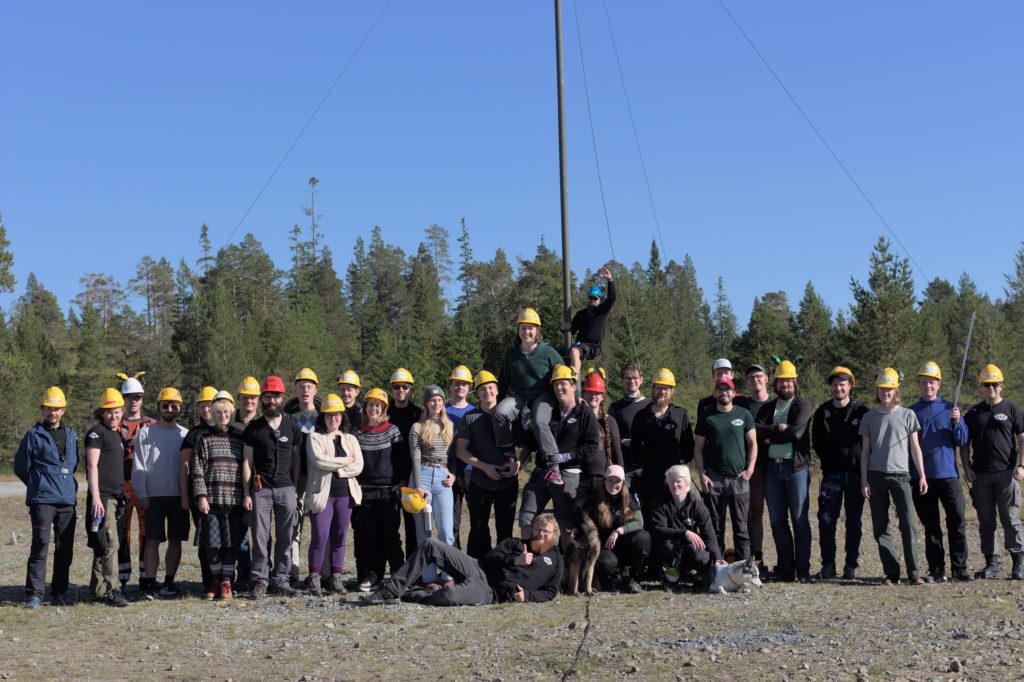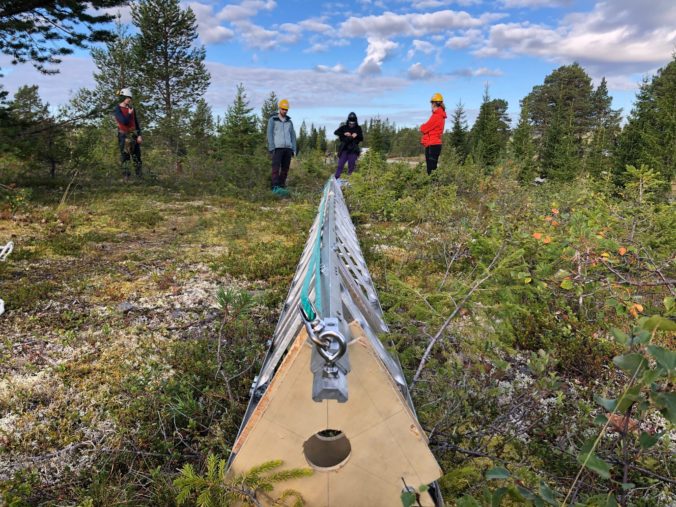The first weekend of September, it was once again time for the annual three-day social competitive excursion, National Field Day. As it occurs every year right after our admission period, it’s a nice way for our new members to get socialised, and most importantly, “radio-lised”.
What makes this contest so attractive for our radio club is that it requires participants to operate from a portable QTH, set up specifically for the occasion. This means we have a great opportunity to bring out our equipment, and likewise practice on setting it up for the occasion.

Photo: LB5DH
Being satisfied with our choice of QTH from the previous years, we decided to go back to Samatun this year as well. The cabin does already sport a nice assortment of beds, but as the number of participants has increased since the pandemic, even more operators had to set up camp outside this year. Luckily Samatun offers plenty enough space for both campers and our accompanying antennas and equipment.

From left LB3SG, LB0ZI, LB5FJ
Photo: SP5SBU
Due to a sudden change of our usual storage space just a few weeks before last years contest, we misplaced some of our equipment during the move and had to resort to using a wire dipole on the 40m band as a backup. This year however, our shortened dipole, the “Bananaphone”, made a comeback. After a trial setup a couple weeks prior and with some minor modifications to the mounting base, the antenna went up and worked well during the course of the weekend. It worked so well it helped the 40m band outperform the 20m band this year, which is a rare occurrence in our Field Day logs.

From left: LB0ZI, Irini and LB5FJ
Photo: SP5SBU

From left: Sindre, LB3SG, LB5DJ, LB5FJ, LB0ZI, LB5GJ and Irini
Photo: SP5SBU
Every year since 2016, we have been using our Spiderbeam multiband yagi-antenna for the 10, 15, and 20m bands. For the first time in those 6 years, we had an incident where one of the supporting beams broke during setup. After a temporary repair, we got it up to altitude, where it, fortunately, remained intact for the duration of the contest.
The rest of the HF+MF bands were covered by wire dipoles, as previously. We daisy chained the 60m dipole with a 80m dipole between the Spiderbeam mast and then onto the Red Cross mast for the Bananaphone. The 160m dipole was hoisted between the Red Cross mast and our remaining Texas tower elements.

From left: LA8ITA, Harald, LA4J, LB5PI, LB4FI(background)
Photo: SP5SPU
Many of the activities that we perform during Field Day have stayed the same for our previous participations, but one of the novel things we have added in the last two years is our attempt at reaching the geostationary satellite, QO-100. Last year, we made a low-effort attempt at reaching QO-100, but due to problems with our TX chain, we were ultimately not heard.
This year LA8ITA and LB3SG tried a new setup and thus made a more serious attempt. Large parts of our setup from the last attempt had disappeared under unknown circumstances, so most of the parts of this year’s setup were new to us. Last year we used separate antennas for TX and RX, but this time LA8ITA and LB3SG made a POTY patch antenna around a Othernet Bullseye. A single antenna for both TX and RX makes adjustments and construction easier.

Photo: LB5DH
In place of LA2QUAs Adam Pluto from last year’s setup, we used LA8ITAs LimeSDR. The transmitter chain consisted of an LNA, then the CN417, same as was used last year. To replace the loss of the two final stages we used LA8ITAs modified 2.4Ghz WiFi amplifier, an EDUP EP-AB003. This would in theory give us around 4-8 W of power, but in reality, probably closer to 4 W. This was around -3 dB less compared to last year, but we crossed our fingers and hoped it still would be enough to make contact.

Photo: SP5SBU
During our testing prior to the contest, we found that we only heard ourselves when transmitting a continuous tone, but not when transmitting SSB. This could be caused by several factors, e.g. that the POTY antenna has a wider beam than the small dish, or that the whole transmitter chain was undersized for operations this far north. We weren’t able to track down the exact cause of the problem at this point, but still believed it could work. This would ultimately have to be solved at Field Day since there was no more time to look at it before leaving.

Photo: SP5SBU
During preparations, we used a small 40 cm dish with the plan of using a larger one from Samatun if necessary. During the setup, however, we realized that the larger dish we had in storage (originally inherited from Orbit NTNU) had a secondary dish before the main one. This is not a problem for QO-100s linearly polarized downlink, but the circularly polarized uplink changes from RHCP to LHCP. This upended the benefit of the larger dish and we believe this was part of the reason we were still not able to be heard through the satellite.
From left: Randi, LB5DH, LB5GJ, LB0ZI, LB4FI and LB8KI
Photo: LB6GH
This year we also made a serious attempt at working one of the LEO (low earth orbit) FM satellites. We have previously had some success with similar approaches back in 2017 and 2018, but in the last few years we have only seen a couple of half-hearted attempts. Our setup this year consisted of a pair of FT-4X handhelds, one used for uplink and one for downlink, and our dual band Arrow II yagi antenna. The results disappointedly reported no QSOs, with several passes not even being heard. We are not sure if this is due to a faulty setup or poor operation, but we will definitely try this more next year.
From left: LB8KI, LB0RI, LB5GJ, LB0ZI and LB5DH
Photo: LB6GH
Last year we got 1097 claimed QSOs, with almost 100 of them being on the digital mode, FT8. It’s a nice side-feature to run contacts on the lesser populated bands (or the bands where we can’t receive very well with SSB) as FT8 also works in poor conditions. Unfortunately for us, the only two Shack-computers with WSJT-X already installed and set up was the two with the most busy bands.
Viljar and LB5DJ set out to get working on the 10 m station, and after a lot of back and forth (downloaded from 4G signals up in the woods!) got it up and running, finally adding the 10 meter band on our QSO list. We also set up WSJT-X on our 15m shack Sunday morning, but with no real success we returned to SSB rather quickly. The 60 m band however proved difficult to master because of issues both with the antenna and radio setup, so we’ll forget about its existence this year.

The shacks stayed highly active during the course of the contest, with the most relevant bands being active almost all 24 hours. Even at nighttime, we had several operators active, which proves important as many of our points, especially on the 160, 80, and 40m bands, come through during the night. After the contest ended 13:00 UTC, we ended up with a total number of 761 QSOs, which is a bit less than usual compared to our scores over the past decade. If we look at the QSOs per hour, we see that in particular, Sunday morning gave fewer points than we have usually had during these early hours.

Photo: LB5DH
Another disappointing discovery during the contest was that the Spiderbeam seemed to have a mind of its own, spinning out of the set direction with the rotor controller. This made it hard to maintain any given direction, which probably contributed to us losing a few of the pile-ups we usually achieve on the 20m band. We believe this unexpected rotation was caused by a loose bolt or clamp somewhere in the system, and will definitely look at this before raising the antenna next year.

Front to back: LB0ZI, Randi, LB5DJ, Viljar, LB5PI, LB9WI.
Photo: SP5SBU
Although our number of QSOs didn’t turn out as high as expected, it seems like everyone had a good time this weekend and were able to partake in at least some of the many radio activities during the weekend. Thanks to all the people who contributed to Field Day this year!

Photo: SP5SBU






0 Comments
1 Pingback